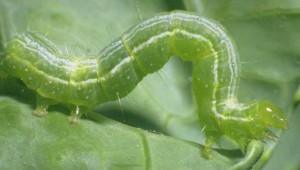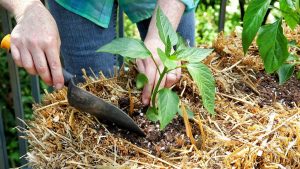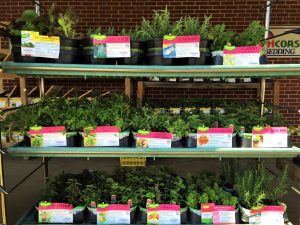 One of the most annoying critters we fight in the cool weather is the cabbage looper. A green inchworm-looking bug that loves leafy plants. They can be very damaging but they are also easy to control. You need to inspect the garden to identify the problem before they get out of hand. The farmers call this crop inspection, scouting. My weapon of choice is Bt (Bacillus thuringiensis). Bt is available in both liquid and powder called Dipel Dust. The liquid should be used with a sticking agent like liquid molasses. The only issue with liquid molasses is that I have had it gum up the sprayer. You don’t have to deal with that if you use the powder but it is very hard to get it to stick to the bottom of a leaf. Spray in the evening as the sun is setting.
One of the most annoying critters we fight in the cool weather is the cabbage looper. A green inchworm-looking bug that loves leafy plants. They can be very damaging but they are also easy to control. You need to inspect the garden to identify the problem before they get out of hand. The farmers call this crop inspection, scouting. My weapon of choice is Bt (Bacillus thuringiensis). Bt is available in both liquid and powder called Dipel Dust. The liquid should be used with a sticking agent like liquid molasses. The only issue with liquid molasses is that I have had it gum up the sprayer. You don’t have to deal with that if you use the powder but it is very hard to get it to stick to the bottom of a leaf. Spray in the evening as the sun is setting.
Did you have issues with squash bugs, squash vine bores, cucumber beetles or root nematodes this past spring? Taking a page from Sun Tzu’s Art of War, attack them when they are at their weakest. That would be in dormancy. The weapon to use is beneficial nematodes. These microscopic, subterranean worms act as parasites on non-beneficial pests. Since the larva of the bad guys is in a dormant state in the soil, they are easy prey for the nematodes. Nematodes are mixed with water and poured through a provided sieve. For garden applications I use a clean watering can, although you can use pump-up or hose-end sprayers. They are applied on damp ground as the sun is setting. Water the area thoroughly after application. The nematodes we carry will cover a quarter of an acre or the large size that covers half of an acre. As always read and follow the label direction. Pick up beneficial nematodes, right here at the store, and win the war against the cabbage looper and other fall garden pests.







 Come learn how to successfully grow the most popular garden crop on the planet, the tomato. Our Tomato Growing Workshop kicks off Saturday, March 5, 2022, at 1:00 pm. This class, held here at the store and will cover all aspects of growing tomatoes. Want to know the difference between “indeterminate” and “determinate”
Come learn how to successfully grow the most popular garden crop on the planet, the tomato. Our Tomato Growing Workshop kicks off Saturday, March 5, 2022, at 1:00 pm. This class, held here at the store and will cover all aspects of growing tomatoes. Want to know the difference between “indeterminate” and “determinate” 
